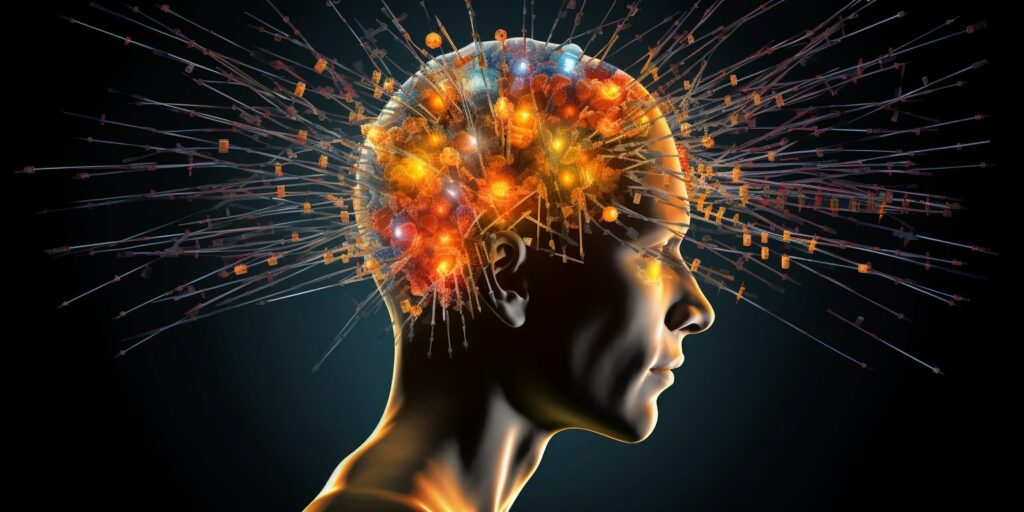Dopamine addiction, a term gaining recognition in recent years, refers to the compulsive seeking and consumption of activities or substances that stimulate the release of dopamine in our brains. Dopamine is a neurotransmitter associated with pleasure, motivation, and reward. While it plays a crucial role in our brain’s reward system, excessive exposure to dopamine can lead to addictive behaviors.
In today’s fast-paced society, we are constantly bombarded with opportunities for instant gratification. From social media notifications to online shopping discounts and even video game achievements, these experiences trigger small bursts of dopamine that keep us coming back for more. Over time, this continuous cycle can develop into an addiction that negatively impacts our well-being.
Understanding the mechanisms behind dopamine addiction is essential if we want to navigate this modern landscape responsibly. By recognizing the signs and consequences of excessive dopamine stimulation, we can make informed choices about how we engage with activities and substances that provide temporary pleasure but may ultimately compromise our long-term happiness and fulfillment.
Understanding Dopamine Addiction
Dopamine addiction is a complex phenomenon that arises from the brain’s reward system. To truly grasp this concept, we need to delve into the intricacies of dopamine and its role in our brain chemistry.
Firstly, let’s establish what dopamine is. It’s a neurotransmitter that acts as a chemical messenger in our brains, playing a crucial role in regulating pleasure, motivation, and reward. When we engage in activities that bring us pleasure or give us a sense of accomplishment, such as eating delicious food or achieving personal goals, dopamine is released.
This release of dopamine creates feelings of satisfaction and reinforces behaviors associated with the pleasurable experience. However, the problem arises when certain activities or substances hijack this natural reward system by flooding the brain with an excessive amount of dopamine.
Take substance abuse as an example. Drugs like cocaine or opioids can cause an overwhelming surge of dopamine in the brain, creating intense feelings of euphoria. Over time, this flood of dopamine alters the brain’s reward pathways and can lead to addiction.
Similarly, behavioral addictions like gambling or excessive internet use can also trigger significant releases of dopamine. The repeated activation of these reward pathways reinforces addictive behaviors and makes it difficult for individuals to break free from their compulsions.
Understanding the underlying mechanisms behind dopamine addiction is crucial for developing effective treatment strategies. By recognizing that addiction stems from dysregulated neural circuits rather than mere lack of willpower, we can approach addiction as a medical condition requiring comprehensive care.
In conclusion (without starting with those words), understanding how dopamine addiction functions within our brains provides valuable insights into why certain behaviors become addictive and how they impact individuals’ lives. By continuing to explore this topic further (as part of an ongoing article), we’ll gain deeper knowledge on effective prevention measures and evidence-based treatments for those battling with addiction.
The Role of Dopamine in Addiction
When it comes to understanding addiction, dopamine plays a pivotal role. It’s a neurotransmitter that acts as a chemical messenger in our brains, playing a key part in our motivation and reward systems. Dopamine is released when we engage in pleasurable activities such as eating delicious food, engaging in social interactions, or even winning a game.
Addiction takes hold when there is an imbalance in the dopamine system. Substance abuse and addictive behaviors can lead to an excessive release of dopamine, flooding the brain with intense feelings of pleasure and reinforcing the desire to repeat the behavior. This creates a powerful association between the substance or behavior and the rewarding feeling it provides.
To put it simply, addiction hijacks our brain’s natural reward system by creating an overwhelming craving for more dopamine. As individuals continue to seek out substances or engage in addictive behaviors, they become trapped in a cycle where they constantly chase that initial rush of pleasure.
Research has shown that long-term drug use can actually alter the way our brain functions. Over time, these changes make it increasingly difficult for individuals to experience pleasure from everyday activities without relying on drugs or other addictive substances.
Understanding this link between dopamine and addiction helps us grasp why breaking free from addiction is so challenging. The constant need for more dopamine drives individuals to prioritize their addictive behaviors over other aspects of their lives, leading to detrimental consequences for their health, relationships, and overall well-being.
It’s important to note that while dopamine certainly plays a significant role in addiction, it’s not solely responsible for its development. Factors like genetics, environment, mental health conditions, and social influences also contribute to an individual’s vulnerability to addiction.
The role of dopamine in addiction cannot be overstated. It fuels the cravings and reinforces addictive behaviors through its impact on our brain’s reward system. By gaining insights into how this neurotransmitter operates within the context of addiction, we can better understand the complexity of addiction and work towards effective prevention and treatment strategies.
Signs and Symptoms of Dopamine Addiction
When it comes to dopamine addiction, there are several signs and symptoms that one should be aware of. Understanding these indicators can help individuals recognize when they may be struggling with an addiction to dopamine. Here are a few examples:
- Cravings: One common sign of dopamine addiction is intense cravings for activities or substances that stimulate the release of dopamine in the brain. Whether it’s constantly seeking out social media likes, engaging in excessive gambling, or relying on drugs and alcohol for pleasure, the craving for that dopamine rush becomes all-consuming.
- Compulsive behavior: Another symptom of dopamine addiction is the development of compulsive behaviors. This could manifest as an uncontrollable urge to engage in certain activities, even if they have negative consequences on personal relationships, work performance, or overall well-being.
- Tolerance: Over time, individuals with dopamine addiction may find that they need more and more stimulation to achieve the same level of satisfaction or pleasure. This increased tolerance can lead to a dangerous cycle where higher doses or more extreme behaviors are required to experience the desired effect.
- Withdrawal symptoms: When someone becomes dependent on dopamine-inducing activities or substances, they may experience withdrawal symptoms when attempting to cut back or quit. These symptoms can range from irritability and restlessness to anxiety and depression.
- Neglecting responsibilities: Dopamine addiction can often result in neglecting important responsibilities such as work, school, family obligations, or personal hygiene. The pursuit of dopamine-driven rewards takes precedence over fulfilling daily duties and obligations.
It’s important to note that everyone’s experience with dopamine addiction may vary based on individual circumstances and underlying factors. If you suspect you or someone you know may be dealing with a dopamine addiction, reaching out for professional help is crucial for understanding and addressing this issue effectively.
Causes and Risk Factors of Dopamine Addiction
Let’s delve into the causes and risk factors behind dopamine addiction. Understanding what contributes to this addictive behavior can shed light on how it develops and why some individuals are more susceptible than others.
- Genetic Predisposition: Research suggests that genetics play a significant role in determining an individual’s vulnerability to addiction. Certain genetic variations can impact how the brain’s reward system, including dopamine receptors, functions. These variations may make some people more prone to seeking out rewarding experiences, leading to a higher likelihood of developing dopamine addiction.
- Environmental Influences: The environment in which we grow up and live can also contribute to dopamine addiction. Factors such as peer pressure, exposure to drugs or high-risk behaviors, and availability of addictive substances can significantly influence an individual’s likelihood of developing an addiction. Stressful life events, trauma, or lack of support systems can further increase the risk.
- Co-occurring Mental Health Disorders: Dopamine addiction often coexists with other mental health conditions like depression, anxiety disorders, or attention-deficit hyperactivity disorder (ADHD). These conditions can create imbalances in brain chemistry and heighten the desire for pleasurable experiences that release dopamine. Treating both the addiction and underlying mental health issues is crucial for successful recovery.
- Neurochemical Imbalances: The brain’s complex neurochemistry plays a vital role in regulating our emotions and behaviors. Imbalances in neurotransmitters like dopamine can disrupt this delicate equilibrium, contributing to addictive tendencies. For instance, chronic drug use can lead to reduced natural dopamine production and increased dependence on external sources for pleasure.
- Social Learning: Human beings are social creatures who learn from observing others’ actions and experiences. If someone grows up witnessing loved ones engaging in addictive behaviors or using substances excessively as coping mechanisms, they may unknowingly adopt similar patterns themselves.
It is important to note that these factors do not guarantee the development of dopamine addiction. Rather, they contribute to an increased susceptibility. Understanding the interplay between genetics, environment, mental health, neurochemistry, and social influences can guide preventative efforts and inform more effective treatment approaches for individuals struggling with dopamine addiction.
Effects of Dopamine Addiction on Mental Health
Dopamine addiction can have significant impacts on mental health. Here are a few examples of how this addiction can affect an individual’s psychological well-being:
- Increased Anxiety and Depression: Excessive dopamine stimulation, often caused by addictive substances or behaviors, can disrupt the brain’s natural balance. This disruption can lead to an increased risk of developing anxiety disorders and depression. The constant craving for dopamine hits creates a cycle where individuals may feel anxious when they aren’t able to satisfy their addiction.
- Impaired Decision-Making Abilities: Dopamine plays a crucial role in the brain’s reward system, influencing our motivation and decision-making processes. When addicted to dopamine, individuals may prioritize seeking pleasure over making rational choices. This impaired decision-making ability can have detrimental effects on various aspects of life, including relationships, finances, and career prospects.
- Poor Impulse Control: Dopamine addiction can impair impulse control mechanisms in the brain, leading to impulsive behavior that is characteristic of addictive disorders. Individuals struggling with dopamine addiction may find it challenging to resist cravings or make long-term decisions that prioritize their overall well-being.
- Reduced Cognitive Functioning: Chronic exposure to high levels of dopamine associated with addiction has been linked to cognitive deficits such as decreased attention span, memory problems, difficulty with problem-solving, and reduced overall cognitive functioning.
- Social Isolation and Relationship Issues: Dopamine addiction often consumes an individual’s time, energy, and resources at the expense of maintaining healthy social connections and relationships. Indulging in addictive behaviors frequently leads to social isolation as individuals prioritize their addictive pursuits over meaningful interactions with loved ones.
These examples illustrate some significant effects that dopamine addiction can have on mental health. It is important for individuals struggling with this type of addiction to seek professional help and support in order to regain control over their lives and improve their overall well-being.
Treatment Options for Dopamine Addiction
When it comes to treating dopamine addiction, there are several approaches that can be effective in helping individuals regain control over their lives. Here are some treatment options that have shown promise:
- Psychotherapy: Therapy sessions with a trained professional can play a crucial role in addressing the underlying causes and triggers of dopamine addiction. Cognitive-behavioral therapy (CBT) is commonly used to help individuals recognize and change unhealthy thought patterns and behaviors associated with addiction. Additionally, motivational interviewing can help individuals find the internal motivation to make positive changes in their lives.
- Medication-Assisted Treatment (MAT): In some cases, medication may be prescribed as part of the treatment plan for dopamine addiction. Medications such as naltrexone or bupropion have been found to be helpful in reducing cravings and managing withdrawal symptoms. However, it’s important to note that medication should always be used under the guidance of a healthcare professional.
- Support Groups: Joining support groups like Narcotics Anonymous (NA) or SMART Recovery can provide individuals with a sense of community and understanding during their recovery journey. These groups offer a safe space for sharing experiences, receiving support from others who have faced similar challenges, and learning new coping strategies.
- Lifestyle Changes: Making healthy lifestyle changes can significantly contribute to overcoming dopamine addiction. Engaging in regular exercise not only helps distract from cravings but also releases natural endorphins that promote well-being. Adopting stress-management techniques such as meditation or yoga can also aid in reducing anxiety levels and promoting overall mental health.
- Family Involvement: In many cases, involving family members or loved ones in the treatment process can enhance recovery outcomes. Family therapy sessions allow for open communication, education about addiction dynamics, and rebuilding trust within relationships.
It’s important to remember that each individual’s journey toward recovery is unique, so finding the right combination of treatments may require some trial and error. Seeking professional guidance from addiction specialists or healthcare providers is crucial to developing a personalized treatment plan that addresses the specific needs and circumstances of the individual.
Remember, recovery is possible with the right support and determination.
Preventing Relapse in Dopamine Addiction Recovery
When it comes to dopamine addiction recovery, preventing relapse is a crucial aspect of the journey. Here are some strategies and tips that can help individuals maintain their progress and stay on track:
- Building a strong support network: Surrounding oneself with supportive family members, friends, or even joining support groups can provide an invaluable source of encouragement and understanding during the recovery process. These connections offer a sense of belonging and accountability, making it easier to resist the temptation to relapse.
- Developing healthy coping mechanisms: Identifying healthier ways to cope with stress, boredom, or other triggers is essential for long-term recovery. Engaging in activities such as exercise, meditation, hobbies, or pursuing new interests can redirect attention away from cravings and promote overall well-being.
- Avoiding high-risk situations: It’s important to steer clear of environments or circumstances that may trigger cravings or temptations. This could involve avoiding certain people, places associated with substance use, or even changing daily routines if necessary.
- Practicing self-care: Prioritizing self-care not only helps improve physical health but also plays a significant role in mental well-being during addiction recovery. Getting enough sleep, eating balanced meals regularly, and managing stress levels are all vital components that contribute to a healthier lifestyle overall.
- Seeking professional help when needed: Sometimes overcoming addiction requires additional guidance from healthcare professionals who specialize in addiction treatment. Therapy sessions or counseling can provide valuable tools for dealing with underlying issues contributing to addictive behaviors.
Remember that each individual’s journey toward recovery is unique; what works for one person may not work for another. It’s crucial to explore different strategies and approaches until finding what resonates most effectively.
By implementing these preventative measures against relapse while focusing on personal growth and healing, individuals undergoing dopamine addiction recovery increase their chances of maintaining long-lasting sobriety and reclaiming control over their lives.
Conclusion
In summary, dopamine addiction is a complex phenomenon that has significant implications for individuals and society as a whole. Throughout this article, we have explored the concept of dopamine addiction, its impact on the brain, and various factors that contribute to its development. Now, let’s take a moment to reflect on what we’ve learned.
- Dopamine addiction is not limited to substances: While most commonly associated with drugs and alcohol, dopamine addiction can also manifest in behaviors such as gambling, shopping, or even excessive use of social media. It highlights the powerful role that dopamine plays in our reward system and how it can lead to compulsive behaviors.
- The cycle of craving and reward: Dopamine addiction operates on a cyclic pattern where cravings for pleasurable experiences drive individuals to seek out rewards that stimulate the release of dopamine in their brains. This cycle reinforces addictive behaviors and makes it challenging for individuals to break free from their addictive patterns.
- Environmental factors play a crucial role: While genetics may predispose certain individuals to be more susceptible to addiction, environmental factors also significantly contribute to the development of dopamine addiction. Stressful life events, peer influence, availability of addictive substances or activities all shape an individual’s likelihood of developing an addiction.
- The brain adapts to prolonged exposure: Prolonged exposure to addictive substances or activities leads to neuroadaptation in the brain’s reward circuitry. Over time, this results in reduced sensitivity to natural rewards leading individuals to rely more heavily on artificial sources of pleasure.
- Seeking professional help is essential: Overcoming dopamine addiction requires professional intervention and support systems tailored specifically for each individual’s needs. A multidisciplinary approach involving therapy, counseling, support groups, and sometimes medication is often necessary for successful recovery.
- Prevention is key: Educating individuals about the risks associated with dopamine addiction from an early age can help prevent future cases by fostering awareness and promoting healthier coping mechanisms. Additionally, implementing policies that regulate the availability and marketing of addictive substances can contribute to reducing the prevalence of addiction.
In conclusion, dopamine addiction is a complex issue with profound effects on individuals and society. Understanding its underlying mechanisms, risk factors, and treatment options is crucial in addressing this growing concern. By raising awareness, providing support, and investing in prevention strategies, we can work towards mitigating the impact of dopamine addiction and promoting healthier lifestyles for all.



